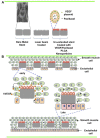Nanoparticle drug- and gene-eluting stents for the prevention and treatment of coronary restenosis
- PMID: 24465275
- PMCID: PMC3900802
- DOI: 10.7150/thno.7210
Nanoparticle drug- and gene-eluting stents for the prevention and treatment of coronary restenosis
Abstract
Percutaneous coronary intervention (PCI) has become the most common revascularization procedure for coronary artery disease. The use of stents has reduced the rate of restenosis by preventing elastic recoil and negative remodeling. However, in-stent restenosis remains one of the major drawbacks of this procedure. Drug-eluting stents (DESs) have proven to be effective in reducing the risk of late restenosis, but the use of currently marketed DESs presents safety concerns, including the non-specificity of therapeutics, incomplete endothelialization leading to late thrombosis, the need for long-term anti-platelet agents, and local hypersensitivity to polymer delivery matrices. In addition, the current DESs lack the capacity for adjustment of the drug dose and release kinetics appropriate to the disease status of the treated vessel. The development of efficacious therapeutic strategies to prevent and inhibit restenosis after PCI is critical for the treatment of coronary artery disease. The administration of drugs using biodegradable polymer nanoparticles as carriers has generated immense interest due to their excellent biocompatibility and ability to facilitate prolonged drug release. Despite the potential benefits of nanoparticles as smart drug delivery and diagnostic systems, much research is still required to evaluate potential toxicity issues related to the chemical properties of nanoparticle materials, as well as to their size and shape. This review describes the molecular mechanism of coronary restenosis, the use of DESs, and progress in nanoparticle drug- or gene-eluting stents for the prevention and treatment of coronary restenosis.
Keywords: Coronary artery disease; Nanoparticle.; Restenosis; Stenosis; Stents.
Conflict of interest statement
Competing Interests: The authors have declared that no competing interest exists.
Figures








Similar articles
-
Local delivery of therapeutics for percutaneous coronary intervention.Curr Drug Deliv. 2011 Sep;8(5):534-56. doi: 10.2174/156720111796642282. Curr Drug Deliv. 2011. PMID: 21696350
-
Drug-eluting stents.Arch Cardiol Mex. 2006 Jul-Sep;76(3):297-319. Arch Cardiol Mex. 2006. PMID: 17091802 Review.
-
Comparison between catheter-based delivery of paclitaxel after bare-metal stenting and drug-eluting stents in coronary artery disease patients at high risk for in-stent restenosis.Cardiovasc Revasc Med. 2017 Dec;18(8):596-600. doi: 10.1016/j.carrev.2017.05.018. Epub 2017 May 31. Cardiovasc Revasc Med. 2017. PMID: 28625402 Clinical Trial.
-
Long-Term Results of Everolimus-Eluting Stents Versus Drug-Eluting Balloons in Patients With Bare-Metal In-Stent Restenosis: 3-Year Follow-Up of the RIBS V Clinical Trial.JACC Cardiovasc Interv. 2016 Jun 27;9(12):1246-1255. doi: 10.1016/j.jcin.2016.03.037. Epub 2016 Jun 20. JACC Cardiovasc Interv. 2016. PMID: 27339840 Clinical Trial.
-
Novel approaches to reduce restenosis.Ann N Y Acad Sci. 2004 May;1015:367-78. doi: 10.1196/annals.1302.032. Ann N Y Acad Sci. 2004. PMID: 15201175 Review.
Cited by
-
The role of atorvastatin on the restenosis process post-PTA in a diabetic rabbit model.BMC Cardiovasc Disord. 2016 Jul 16;16:153. doi: 10.1186/s12872-016-0324-1. BMC Cardiovasc Disord. 2016. PMID: 27422557 Free PMC article.
-
The Use of Bioactive Polymers for Intervention and Tissue Engineering: The New Frontier for Cardiovascular Therapy.Polymers (Basel). 2021 Jan 30;13(3):446. doi: 10.3390/polym13030446. Polymers (Basel). 2021. PMID: 33573282 Free PMC article. Review.
-
Critical regulation of atherosclerosis by the KCa3.1 channel and the retargeting of this therapeutic target in in-stent neoatherosclerosis.J Mol Med (Berl). 2019 Sep;97(9):1219-1229. doi: 10.1007/s00109-019-01814-9. Epub 2019 Jun 28. J Mol Med (Berl). 2019. PMID: 31254004 Review.
-
Nanomedicines for cardiovascular disease.Nat Cardiovasc Res. 2023 Apr;2(4):351-367. doi: 10.1038/s44161-023-00232-y. Epub 2023 Apr 3. Nat Cardiovasc Res. 2023. PMID: 39195953 Review.
-
Structure-Based Varieties of Polymeric Nanocarriers and Influences of Their Physicochemical Properties on Drug Delivery Profiles.Adv Sci (Weinh). 2022 Apr;9(10):e2105373. doi: 10.1002/advs.202105373. Epub 2022 Feb 3. Adv Sci (Weinh). 2022. PMID: 35112798 Free PMC article. Review.
References
-
- Deaton C, Froelicher ES, Wu LH, Ho C. et al. The global burden of cardiovascular disease. J Cardiovasc Nurs. 2011;26(4 Suppl):S5–S14. - PubMed
-
- World Health Statistics 2008. WHO; http://www.who.int/whosis/whostat/2008/en/index.html.
-
- Kavanagh CA, Rochev YA, Gallagher WM. et al. Local drug delivery in restenosis injury: thermoresponsive co-polymers as potential drug delivery systems. Pharmacol Ther. 2004;102:1–15. - PubMed
-
- Hamon M, Lecluse E, Monassier JP. et al. Pharmacological approaches to the prevention of restenosis after coronary angioplasty. Drugs Aging. 1998;13:291–301. - PubMed
-
- Burta HM, Hunter WL. Drug-eluting stents: a multidisciplinary success story. Adv Drug Deliv Rev. 2006;58:350–7. - PubMed
Publication types
MeSH terms
Substances
LinkOut - more resources
Full Text Sources
Other Literature Sources
Medical
Miscellaneous

